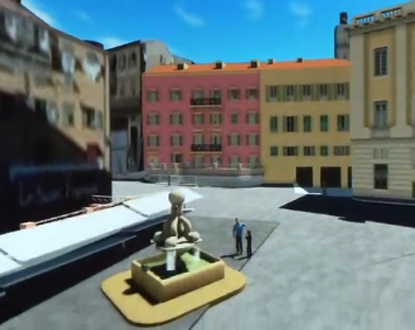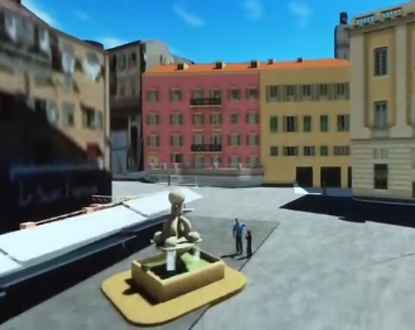While awaiting the court’s decision, expected today, on the occupation of the former Aigle d’Or premises by CGT militants, the controversy between the Mayor of Nice and opposition member Robert Injey continues to be intense.

The problem is that neither party wants to appear to be giving in, for fear of looking weak. When pride replaces logic, progress is not made. But how long will this go on? Shouldn’t the general interest take precedence over individual concerns?
During the municipal council meeting on Monday, June 25, 2012, part of the debate focused on the future of Place Saint François and the CGT’s presence there. The mayor presented a resolution to repeal the 1892 and 1954 decisions, which had attributed the former communal palace/Labor exchange and the Aigle d’Or to the CGT. Ignoring the remarks and proposals I made, the Mayor of Nice justified his decision with questionable arguments, and more notably, he reneged on the commitments from 2009, formalized by a bilateral agreement with the CGT.
Today, as this case progresses in the judicial arena, it is useful to examine five specific questions to try to determine what constitutes deceit or approximation.
First question: In signing an agreement in 2009 with the CGT, promising their return to the Aigle d’Or post-restoration, did the mayor know the building’s historical reality?
Today, he claims he didn’t and that he was only informed of this situation in March 2010.
First of all, I am surprised that between March 2010 and May 3, 2012, he did not take the time to inform the CGT of this new situation.
The reality is much simpler, as this situation was not new at all. It was already well-known with great precision by the city services since spring 2006.
Indeed, during this period, an archeological services team of the City of Nice conducted a study of the Aigle d’Or building, involving nearly 20 surveys within the building walls to “observe the masonry characteristics while deciphering their compositions.”
This meticulous work was publicly released with an article by Fabien BLANC in the ARCHEAM magazine in 2007 (issue #14) published and distributed in the first half of 2007. This detailed, 25-page article (pages 95 to 118) covered the building’s reality. In the magazine’s introduction (page 7), city archeologist Mr. Marc BOUIRON noted: “the identification of the Franciscan convent remains with much more precision …”
By signing the 2009 agreement concerning the Aigle d’Or, C. ESTROSI and his team could not have ignored this study. He and the City of Nice were precisely aware of this aspect of the case. Yes, in 2009 the mayor knew, and his decision on May 3, 2012, not to reinstate the CGT at Place Saint François was unrelated to the building’s historical characteristics.
Second question: Is there an incompatibility between enhancing the cloister and the building’s use by the CGT?
Not at all. As seen in the video produced by the City of Nice, it is clear that the cloister section meant for enhancement is a corridor about ten meters long and two meters wide, lacking any communication with the rest of the Aigle d’Or building. Unable to argue this nonexistent impossibility, Christian ESTROSI resorts to an authoritative argument, “I don’t want offices here, just like the Ministry of Finance left the Louvre!” The Mayor of Nice must have missed the fact that the Aigle d’Or is not the Louvre!
Today, apart from the basement and the cloister gallery, the Aigle d’Or building contains no remarkable architectural elements—no frescoes, woodwork, or decoration… none! Evidence of this is that “Buildings of France” allowed the construction of a substantial concrete shaft for an elevator over four levels.
The fact remains: the CGT can easily be present in this building without disrupting the cloister’s enhancement.
Third question: Between the Franciscans and the labor movement, who has greater legitimacy at Place Saint François?
The question is absurd, but since the Mayor of Nice brought it up, let’s address it!
“Legitimacies” do not conflict; both contribute to the city’s history. With one difference, one strictly belongs to the past, while the other remains highly relevant today through active representation of more than 12,000 members, elected officials in numerous companies, and hundreds of workers defended in labor courts.
Moreover, the worker’s presence at this city location predates the existence of the Labor Exchange. During the French Revolution and the First Empire, Place Saint François was called “Place des Ouvriers” (Place of Workers) (Article by Madame Caroline CHALLAN DELVAL, in Archeam issue #14, 2007, page 75). A rather uncommon designation undoubtedly references this location’s activities at the end of the 18th century and likely before.
Honoring the memory of the Franciscan presence until 1792 does not oppose allowing the labor movement to leave its mark on this place as it has for over two centuries. Respecting the past without derisive attitudes toward the present and future should define the Mayor of Nice’s stance…
Fourth question: Is the matter settled following the City Council vote?
The final outcome is likely distant. Partly due to the ongoing legal proceedings, and partly because the place’s history is already replete with unsuccessful attempts.
Indeed, this is not the first attempt to remove the CGT from Place Saint François. On May 3, 1902 (also a May 3), then-Mayor Honoré SAUVAN cited friction between pro and anti-municipal unions as justification for closing the Exchange. It wasn’t until May 1906 that the CGT officially took possession of the Labor Exchange.
In 1940, the Vichy government dissolved the CGT… it returned to Place Saint François on August 28, 1944…
In 1950, the civil tribunal of Nice ordered CGT’s eviction from the Aigle d’Or. The premises requisitioned in 1944 remained occupied. Eventually, Jean MEDECIN commenced a procedure for the city to acquire the premises, assigning them to the CGT under the municipal council’s decision.
Ultimately, it’s up to the CGT and its organizations to decide the case’s next steps. Considering the last 120 years’ history… it is presumptuous to believe one can shut the door on over a century of presence…
Fifth Question: What about FILLEY Barracks?
An argument for reclaiming the communal palace yesterday and now the Aigle d’Or is to establish a local history museum. Setting aside that the former communal palace was listed as a historical monument in December 1949 under the designation “Bourse du travail,” the location seems ill-suited for a grandiose museographic endeavor. If Nice is to create a worthy local history museum, a viable site emerges: the Filley Barracks. During the City Council debate, the Mayor dismissed this possibility of creating a local history museum there, contemptuously referring to “buildings barely 100 years old.”
What ignorance about our city’s heritage reality! I give the floor to Monseigneur Denis GHIRALDI regarding the “Monastère de saint Martin, Saint Augustin”: “The convent constructed by the Augustinians following their installation at the Saint Martin Church in 1405 didn’t have the size of its current form, eventually transformed into Filley Barracks.” Construction began in 1716, nearly 300 years ago!
Unless Christian ESTROSI has another idea for this location. In 2008, the city was said to repurchase Filley Barracks, with Nice-Matin reporting on November 23, 2008, “Christian Estrosi dreams aloud: ‘We could conduct a beautiful urban development operation there, serving the population and neighborhood. I’ll launch an architectural competition to create cultural and sports facilities there.’ A gymnasium and sports hall for the school and population, a meeting hall for associations, a parking lot for the neighborhood… If no obstacles arise, the property transfer could occur by the end of 2009.”
“Urban development operation” often rhymes with “speculative real estate operation,” not to mention a parking lot instead of an early 18th-century cloister—details Christian ESTROSI forgot to disclose…
Robert INJEY
City Councilor of Nice



